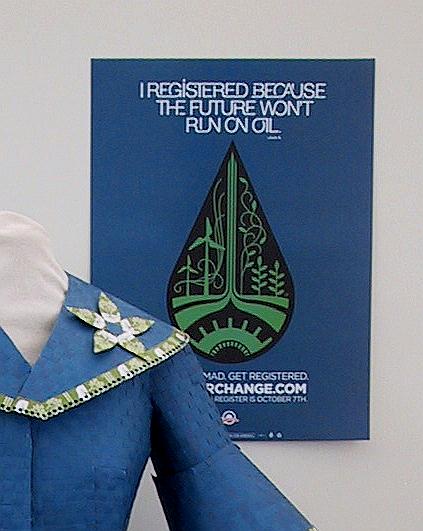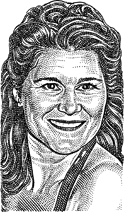The Wall Street Journal
SANTA FE, N.M. — In the world of trashy fashion, designer Nancy Judd has hit the big time.
FRONT PAGE
January 13, 2009
By Stephanie Simon
Read article on-line.
Ms. Judd spends her days in a studio here crafting clothing from castoff plastic bags, electrical wire and old cassette tapes. Now, her Dumpster couture has caught the eye of environmental activists, who plan to showcase her work in Washington at Saturday’s Green Inaugural Ball honoring President-elect Barack Obama.
The star piece: A man’s coat made from Mr. Obama’s campaign fliers. She says it took her 200 hours to cut and paste and sew it.
Showing her stuff in the nation’s capital is a big step for a woman who used to put on a furry blue costume and sweat her way through parades as Carlos Coyote, Santa Fe’s recycling mascot. Working for the city trash department, Ms. Judd did the coyote gig for years. She also ran workshops and recorded radio ads urging New Mexicans to recycle. But she worried that nobody was paying attention.
Ms. Judd began to wonder whether she could spark new interest in solid waste by making garbage glamorous.
Ms. Judd, who is 40 years old, has no training in fashion. She can’t sketch. She gets design ideas from old paper dolls. Still, she figured out how to craft a saucy cocktail dress from a shower curtain and aluminum cans. She fashioned a slinky black gown from canvas scraps and hundreds of rusty nails. When worn, it clinks alluringly.
She once spent 400 hours, she says, unspooling cassettes and crocheting the crinkled tape into a fake-fur coat.
As attire, the outfits have their limitations. An evening gown sparkling with 12,000 bits of glass tends to shed; a fitted jacket cut from the vinyl top of a convertible is so well insulated, it doubles as a sweat lodge.
Also, says Ms. Judd, “you can’t sit down in any of them.”
What steps are you taking to live “green” or protect the environment?
.But these aren’t meant to be wardrobe mainstays. Ms. Judd conceives of them more as wearable sculpture. “I like the idea of making aluminum elegant, or rusty nails sexy,” she says.
Turns out, she isn’t alone.
A decade ago, when Ms. Judd was making her first rescued-from-the-landfill dress — a somewhat revealing number made of bubble wrap — recycling had already hit the mainstream. Manufacturers were turning plastic bottles into fleece outdoor wear.
But the world of environmentally conscious designers was small, says Delia Montgomery, founder of Chic Eco, an “earth friendly” fashion consulting firm. “Now I can’t keep up,” she says.
Woven Candy Wrappers
Artisans in developing countries sell purses woven from candy wrappers. Online boutiques market belts made from the inner tubes of bicycles. A designer in Chile recently announced she had pulled apart the filters in cigarette butts and woven them into a coarse thread to crochet vests.
By necessity, most of this experimentation is small-scale. It takes a whole lot of time to scrub the coffee residue from empty Starbucks bags, then snip out the mylar lining for use in a gown. “Anyone trying to mass-produce this throws their hands up in the air,” Ms. Montgomery says.
But for boutique designers, the niche market is enough. “The sheer weirdness of it — people just love it,” says Robin Worley, a fashion designer in Seattle who studs her clothes with gears from discarded watches.
The concept has infiltrated pop culture on cable television, thanks to the Bravo reality series “Project Runway,” which has challenged aspiring designers to construct outfits from recyclables.
Two years ago, Ms. Judd decided to try to capitalize on the emerging trend by turning her hobby into a full-time job through a business she calls Recycle Runway.
She doesn’t sell her work; she markets it as an educational tool. She wants to use her Dumpster couture — otherwise known as “trashion” — to illustrate talks about the solid-waste problem and to raise awareness through instructive art exhibits.
“You can’t be didactic or shaming or all gloom-and-doom” when talking about sustainability, or the audience may tune out, Ms. Judd says. “So you sneak in the back door” with fanciful fashions.
The concept intrigued curators at the Pittsburgh International Airport, who organized a show on Concourse C this past fall. When she came to set up the exhibit, Ms. Judd also spoke to several youth groups.
“The children were amazed to see that something so beautiful could be created out of something we would normally throw away,” says Pat Bluett, assistant executive director of a suburban Boys and Girls Club. The club’s recycling volume has since doubled, she says.
The educational theme also appealed to Jenna Mack, co-producer of Saturday’s Green Inaugural Ball. The all-organic, $500-a-ticket event is expected to draw 1,000 environmentalists. Models will show off Ms. Judd’s fashions on platforms in the lobby.
“Maybe the mental image of that dress made from glass might make people think twice before they throw out a bottle next time,” Ms. Mack says.
The whimsy factor also gives Ms. Mack bragging rights on a party-packed weekend with dueling environmental-themed galas. The other Green Inaugural Ball has Al Gore. This one has Ms. Judd’s canvas-scrap dress embroidered with shiny flowers cut from Coke cans.
Glad as she is to be heading to Washington, Ms. Judd won’t make any money from the show. (In fact, she’s selling tote bags made from recycled Obama signs to cover her expenses.) In general, she has found profits don’t match her passion; these past two years, she has been living mostly on savings and a small-business loan. But she is undeterred.
The morning after the November election, Ms. Judd hoisted herself into a Dumpster outside an Obama campaign office and scooped up armfuls of posters. She collected a precinct map, a phone list, a pink flier advertising sweatshirts, a child’s drawing of the Obama logo as a scoop of ice-cream, over the slogan, “Yum We Can.”
Dumping it out on her studio floor the other day, Ms. Judd gazed at her loot. Some of the paper was crumpled and torn; there were footprints on one sign, and smears of paint. “Won’t it be so fun to use this?” she asked.
She has already made three items of Obama-wear: A sun dress stitched from plastic yard signs; a suit woven from strips of voter-registration posters; and the man’s coat, made from stiffly lacquered door hangers.
Ms. Judd looked up Mr. Obama’s measurements and tailored the coat for him. She wishes he would stop by to try it on. After some trial and error, she figured out how to hinge the sleeves to give him some measure of mobility. “He can’t wave,” she says. “But he can shake a hand.”









































